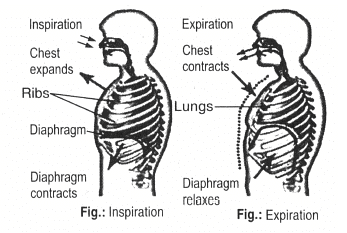Class 7 Exam > Class 7 Questions > During exhalation, in which direction do the ...
Start Learning for Free
During exhalation, in which direction do the ribs move?
- a)Outwards
- b)Downwards
- c)Upwards
- d)To normal position
Correct answer is option 'B'. Can you explain this answer?
Most Upvoted Answer
During exhalation, in which direction do the ribs move?a)Outwardsb)Dow...
Understanding Rib Movement During Exhalation
When we exhale, the movement of the ribs plays a crucial role in the mechanics of breathing. Here's a detailed explanation of how this process works:
1. Role of the Diaphragm
- The diaphragm, a dome-shaped muscle at the base of the thoracic cavity, contracts during inhalation, pulling downward and expanding the chest cavity.
- During exhalation, the diaphragm relaxes and moves back up, decreasing the volume of the chest cavity.
2. Rib Movement
- As the diaphragm rises, the ribs also move. Specifically, they move downward.
- The intercostal muscles, which are located between the ribs, help facilitate this movement. When these muscles relax, the ribs are pulled down and inwards.
3. Pressure Changes
- The downward movement of the ribs reduces the volume in the thoracic cavity, leading to an increase in pressure.
- This pressure forces air out of the lungs, allowing us to exhale effectively.
4. Conclusion
- Therefore, during exhalation, the ribs primarily move downwards. This movement is essential for the efficient expulsion of air from the lungs.
- Understanding this mechanism highlights the intricate relationship between muscle actions and respiratory function.
In summary, the correct answer to the question is option 'B': during exhalation, the ribs move downwards, facilitating the process of breathing out.
When we exhale, the movement of the ribs plays a crucial role in the mechanics of breathing. Here's a detailed explanation of how this process works:
1. Role of the Diaphragm
- The diaphragm, a dome-shaped muscle at the base of the thoracic cavity, contracts during inhalation, pulling downward and expanding the chest cavity.
- During exhalation, the diaphragm relaxes and moves back up, decreasing the volume of the chest cavity.
2. Rib Movement
- As the diaphragm rises, the ribs also move. Specifically, they move downward.
- The intercostal muscles, which are located between the ribs, help facilitate this movement. When these muscles relax, the ribs are pulled down and inwards.
3. Pressure Changes
- The downward movement of the ribs reduces the volume in the thoracic cavity, leading to an increase in pressure.
- This pressure forces air out of the lungs, allowing us to exhale effectively.
4. Conclusion
- Therefore, during exhalation, the ribs primarily move downwards. This movement is essential for the efficient expulsion of air from the lungs.
- Understanding this mechanism highlights the intricate relationship between muscle actions and respiratory function.
In summary, the correct answer to the question is option 'B': during exhalation, the ribs move downwards, facilitating the process of breathing out.
Free Test
FREE
| Start Free Test |
Community Answer
During exhalation, in which direction do the ribs move?a)Outwardsb)Dow...
During exhalation, i.e. releasing air during respiration, the ribs move downwards to reduce the volume of the thoracic cavity.
During exhalation, your diaphragm relaxes and moves upward into the chest cavity. The intercostal muscles between the ribs also relax to reduce the space in the chest cavity. As they relax they position the rib cage downwards and inwards.

During exhalation, your diaphragm relaxes and moves upward into the chest cavity. The intercostal muscles between the ribs also relax to reduce the space in the chest cavity. As they relax they position the rib cage downwards and inwards.


|
Explore Courses for Class 7 exam
|

|
Question Description
During exhalation, in which direction do the ribs move?a)Outwardsb)Downwardsc)Upwardsd)To normal positionCorrect answer is option 'B'. Can you explain this answer? for Class 7 2025 is part of Class 7 preparation. The Question and answers have been prepared according to the Class 7 exam syllabus. Information about During exhalation, in which direction do the ribs move?a)Outwardsb)Downwardsc)Upwardsd)To normal positionCorrect answer is option 'B'. Can you explain this answer? covers all topics & solutions for Class 7 2025 Exam. Find important definitions, questions, meanings, examples, exercises and tests below for During exhalation, in which direction do the ribs move?a)Outwardsb)Downwardsc)Upwardsd)To normal positionCorrect answer is option 'B'. Can you explain this answer?.
During exhalation, in which direction do the ribs move?a)Outwardsb)Downwardsc)Upwardsd)To normal positionCorrect answer is option 'B'. Can you explain this answer? for Class 7 2025 is part of Class 7 preparation. The Question and answers have been prepared according to the Class 7 exam syllabus. Information about During exhalation, in which direction do the ribs move?a)Outwardsb)Downwardsc)Upwardsd)To normal positionCorrect answer is option 'B'. Can you explain this answer? covers all topics & solutions for Class 7 2025 Exam. Find important definitions, questions, meanings, examples, exercises and tests below for During exhalation, in which direction do the ribs move?a)Outwardsb)Downwardsc)Upwardsd)To normal positionCorrect answer is option 'B'. Can you explain this answer?.
Solutions for During exhalation, in which direction do the ribs move?a)Outwardsb)Downwardsc)Upwardsd)To normal positionCorrect answer is option 'B'. Can you explain this answer? in English & in Hindi are available as part of our courses for Class 7.
Download more important topics, notes, lectures and mock test series for Class 7 Exam by signing up for free.
Here you can find the meaning of During exhalation, in which direction do the ribs move?a)Outwardsb)Downwardsc)Upwardsd)To normal positionCorrect answer is option 'B'. Can you explain this answer? defined & explained in the simplest way possible. Besides giving the explanation of
During exhalation, in which direction do the ribs move?a)Outwardsb)Downwardsc)Upwardsd)To normal positionCorrect answer is option 'B'. Can you explain this answer?, a detailed solution for During exhalation, in which direction do the ribs move?a)Outwardsb)Downwardsc)Upwardsd)To normal positionCorrect answer is option 'B'. Can you explain this answer? has been provided alongside types of During exhalation, in which direction do the ribs move?a)Outwardsb)Downwardsc)Upwardsd)To normal positionCorrect answer is option 'B'. Can you explain this answer? theory, EduRev gives you an
ample number of questions to practice During exhalation, in which direction do the ribs move?a)Outwardsb)Downwardsc)Upwardsd)To normal positionCorrect answer is option 'B'. Can you explain this answer? tests, examples and also practice Class 7 tests.

|
Explore Courses for Class 7 exam
|

|
Signup for Free!
Signup to see your scores go up within 7 days! Learn & Practice with 1000+ FREE Notes, Videos & Tests.























